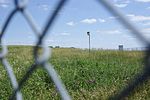Love Canal is a neighborhood in Niagara Falls, New York, United States, infamous as the location of a 0.28 km2 (0.11 sq mi) landfill that became the site of an enormous environmental disaster in the 1970s. Decades of dumping toxic chemicals killed residents and harmed the health of hundreds, often profoundly; the area was cleaned up over the course of 21 years in a Superfund operation.
In 1890, Love Canal was created as a model planned community, but was only partially developed. In the 1920s, the canal became a dump site for municipal refuse for the city of Niagara Falls. During the 1940s, the canal was purchased by Hooker Chemical Company, which used the site to dump 19,800 t (19,500 long tons; 21,800 short tons) of chemical byproducts from the manufacturing of dyes, perfumes, and solvents for rubber and synthetic resins.
Love Canal was sold to the local school district in 1953, after the threat of eminent domain. Over the next three decades, it attracted national attention for the public health problems originating from the former dumping of toxic waste on the grounds. This event displaced numerous families, leaving them with longstanding health issues and symptoms of high white blood cell counts and leukemia. Subsequently, the federal government passed the Superfund law. The resulting Superfund cleanup operation demolished the neighborhood, ending in 2004.
In 1988, New York State Department of Health Commissioner David Axelrod called the Love Canal incident a "national symbol of a failure to exercise a sense of concern for future generations". The Love Canal incident was especially significant as a situation where the inhabitants "overflowed into the wastes instead of the other way around". The University at Buffalo Archives house a number of primary documents, photographs, and news clippings pertaining to the Love Canal environmental disaster; many items have been digitized and are viewable online.








